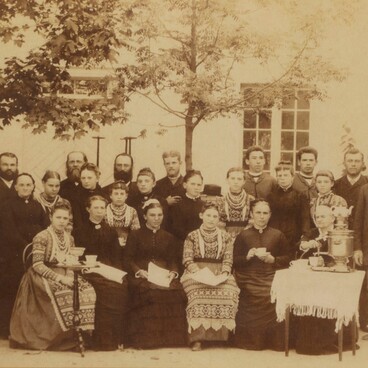The history of the German colony of Sarepta is inextricably linked with the life and work of the Glitch family - the most influential and wealthy in the settlement. The 1904 photograph shows representatives of different generations of this family at the golden wedding of Alexander and Sophia Glitch.
A century earlier, in 1805, Johann Kaspar Glitch had come from Germany to Sarepta. In 1806 he married Charlotte Henrietta Neitz, daughter of Johann Konrad Neitz, the first Sarepta missionary. For several years he had been experimenting with growing mustard and making mustard butter.
Gray mustard came to the Lower Volga region from Asia as a weed with flax and millet seeds. It grew here in the wild for a long time, without attracting the attention of the local population. However, thanks to Neitz and Glitch, mustard began to be grown in the region as an agricultural crop.
Johannes Glitch began to help his father-in-law in organizing mustard production and study the peculiarities of mustard cultivation. They opened the first Russian mustard-oil mill in Sarepta in 1810. The Sarepta Mustard Factory produced high-quality mustard powder and edible mustard oil of long storage, which were highly valued in Russia and Europe.
The business of Johannes Glitch was continued by his sons, Konstantin and Ludwig. Trading house ‘Heirs of J.K. Glitch in Sarepta’ strived to maintain its reputation and quality as a reference Sarepta mustard. The manufacturers personally supervised the production process, tried to give their sons a higher technical education and shared production secrets. Many family members completed internships and worked in factories in Germany.
Representatives of the Glitch family were members of the brotherly community of Sarepta, so they could not stay away from her life. The Glitches donated large sums to repair the Sarepta church, and also helped other community institutions.
They have repeatedly provided funds for the purchase of medical instruments, medicines, equipment for the pharmacy and hospital in Sarepta. The Glitches also patronized the Sarepta schools for boys and girls. They supplied the students and the library with educational literature, visual aids, collections of antiquities, stuffed birds.
In the 1830s and 1840s, other mustard factories began to appear in neighboring villages. In Sarepta itself, in 1849, another mustard plant appeared, which was owned by a local resident, Alexander Knoblokh. Large mustard factories were also built in Tsaritsyn - that was the name of Volgograd until 1925.
There were 14 mustard enterprises in the Tsaritsyn district, apart from the Glich factory by the beginning of the 20th century. However, the quality of their products was inferior, and none of them was able to repeat the production and commercial success of Glitches.
Prior to the October Revolution of 1917, four generations of the Glitch industrial dynasty changed. There were no more families in Sarepta who would have left such a noticeable mark not only in the history of the settlement, but in the whole of Russia. After the revolution, the Glitch family emigrated to their historical homeland in Switzerland.
A century earlier, in 1805, Johann Kaspar Glitch had come from Germany to Sarepta. In 1806 he married Charlotte Henrietta Neitz, daughter of Johann Konrad Neitz, the first Sarepta missionary. For several years he had been experimenting with growing mustard and making mustard butter.
Gray mustard came to the Lower Volga region from Asia as a weed with flax and millet seeds. It grew here in the wild for a long time, without attracting the attention of the local population. However, thanks to Neitz and Glitch, mustard began to be grown in the region as an agricultural crop.
Johannes Glitch began to help his father-in-law in organizing mustard production and study the peculiarities of mustard cultivation. They opened the first Russian mustard-oil mill in Sarepta in 1810. The Sarepta Mustard Factory produced high-quality mustard powder and edible mustard oil of long storage, which were highly valued in Russia and Europe.
The business of Johannes Glitch was continued by his sons, Konstantin and Ludwig. Trading house ‘Heirs of J.K. Glitch in Sarepta’ strived to maintain its reputation and quality as a reference Sarepta mustard. The manufacturers personally supervised the production process, tried to give their sons a higher technical education and shared production secrets. Many family members completed internships and worked in factories in Germany.
Representatives of the Glitch family were members of the brotherly community of Sarepta, so they could not stay away from her life. The Glitches donated large sums to repair the Sarepta church, and also helped other community institutions.
They have repeatedly provided funds for the purchase of medical instruments, medicines, equipment for the pharmacy and hospital in Sarepta. The Glitches also patronized the Sarepta schools for boys and girls. They supplied the students and the library with educational literature, visual aids, collections of antiquities, stuffed birds.
In the 1830s and 1840s, other mustard factories began to appear in neighboring villages. In Sarepta itself, in 1849, another mustard plant appeared, which was owned by a local resident, Alexander Knoblokh. Large mustard factories were also built in Tsaritsyn - that was the name of Volgograd until 1925.
There were 14 mustard enterprises in the Tsaritsyn district, apart from the Glich factory by the beginning of the 20th century. However, the quality of their products was inferior, and none of them was able to repeat the production and commercial success of Glitches.
Prior to the October Revolution of 1917, four generations of the Glitch industrial dynasty changed. There were no more families in Sarepta who would have left such a noticeable mark not only in the history of the settlement, but in the whole of Russia. After the revolution, the Glitch family emigrated to their historical homeland in Switzerland.



